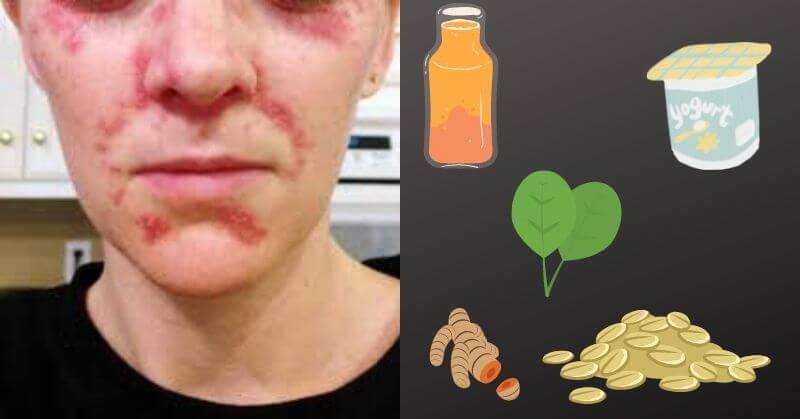If there is a red rash around the mouth, it may be the symptoms of dermatitis called perioral dermatitis. The skin appears scaly and flaky. The inflamed bumps formed can cause itching and burning. Here we will try to come up with the proper Perioral Dermatitis Diet to reduce red rashes around the mouth.
What is Perioral Dermatitis?
Perioral dermatitis is a type of dermatitis that appears in the form of red rashes around the mouth. It can spread to the nose and eyes. The skin becomes scaly, dry, and flaky with inflamed bumps called papules.
The word perioral means “around the mouth”. It can split as peri and oral and has meaning around and mouth respectively. This is not a contagious condition. It can occur at any age and more commonly occurs in the age group between 15 to 45 years old. This is more common in women than men.
Perioral Dermatitis Causes
There is no proven cause for perioral dermatitis. Research and experts found some possible causes. The main cause of perioral dermatitis is using topical steroids on the skin. It may prescribe for other skin conditions and the next possible cause is using steroid nasal sprays.
There are other causes based on the product you use in your day-to-day life. Petrolatum in moisturizers and heavy skin creams can cause perioral dermatitis. Fluoride in the toothpaste, the chemical in sunscreens, sodium Laureth sulfate in shampoos and cleansers can also this condition.
And other medical conditions that can cause perioral dermatitis are hormonal imbalance, dysfunction of the epidermal barrier, and failed immune system. The microorganism and bacteria living in the body and outer skin can also cause perioral dermatitis. Some of them are altered cutaneous microflora, follicular fusiform bacteria, and Candida Albicans.
Perioral Dermatitis Symptoms
The red rash around the mouth is the main symptom of perioral dermatitis. Inflamed bumps called papules can see along with scaly, and flaky rash.
It can spread to your eyelids, nose, ears, neck, scalp, and trunk. In rare conditions, conjunctivitis can see in some people. It may turn the eye pink in color.
Is There Any Perioral Dermatitis Diet To Follow?
Perioral dermatitis is not contagious. It may become chronic in some people and recur. When are you approaching the doctor, you will prescribe some topical medications. Some common medications prescribed for perioral dermatitis are erythromycin gel, clindamycin gel, metronidazole cream or gel, tacrolimus ointment, azelaic acid, adapalene, and a few more.
To help with inflammation, some oral antibiotics such as tetracycline, doxycycline, and erythromycin may prescribe. Still, this prescription will not cure but can provide long-term remission. The rashes can reappear.
You can avoid using products that cause perioral dermatitis. It is good to stop using topical steroids and sprays to avoid this condition.
What Are The Foods Can Add To Perioral Dermatitis?
In addition to the medication, you can follow a perioral dermatitis diet to control and prevent recurrences of perioral dermatitis.
Provenly, there is no proper diet for perioral dermatitis. But adding the given below list of foods, you can control perioral dermatitis.
- Apple cider vinegar: the anti-inflammatory in apple vinegar absorbs excess oil and unplug blocked pores.
- Grapefruit extract: it has antiseptic and antibacterial properties. It smoothens and cleans the skin.
- Aloe vera: it keeps the skin moisture. It treats acne and sunburn
- Oatmeal: it helps in soothing dry and irritated skin.
- Yogurt: calcium in yogurt helps in the healing of dry skin. The zinc in it helps cure inflammation.
- Honey: Honey has antioxidants, antiseptic and antibacterial properties. It helps in providing clean and soft skin.
- Turmeric: it also contains antioxidant and anti-inflammatory substances. It gives a natural glow to the skin.
- Neem oil: it helps in reducing pigmentation in the skin. It helps in curing dark spots and scars.
- Quinoa and millets: Vitamin A in quinoa degrades the aging process. Vitamin B12 in quinoa can improve skin elasticity.
- Broccoli: it helps in healing and keeps the skin healthy.
- Spinach and fenugreek: Vitamin A in spinach can control the oil production in the skin pores. The vitamin C in fenugreek lightens and glows the skin.
What Foods To Avoid In Perioral Dermatitis?
Like adding some food, avoiding certain foods is good for controlling perioral dermatitis.
- Stop consuming alcohol: it promotes itching and rashes.
- Avoid dairy products: sugar content in dairy products can cause acne.
- Sugar and beverages like coffee
- Spices like cinnamon: can cause skin irritation, discoloration, and burning.
- Processed food and spicy and salty food.
It is a known fact that there is no exact treatment and cure for perioral dermatitis. By adopting the above-mentioned perioral dermatitis diet, you can control perioral dermatitis skin problems. However, it is always best to consult your doctor before following the diet for this health condition. Share all your other medical conditions to get proper treatment and medication.
Also Read : Diet Tips To Eliminate Tinea Versicolor Skin Infection And Its Symptoms
Follow Us: Facebook | Instagram | Twitter | Youtube | Pinterest
Tinydale is on YouTube, Click here to subscribe for the latest videos and updates.
The article written by me is for information purposes only. It is not intended to provide medical advice. The reader should always consult a Medical practitioner concerning any medical condition.

